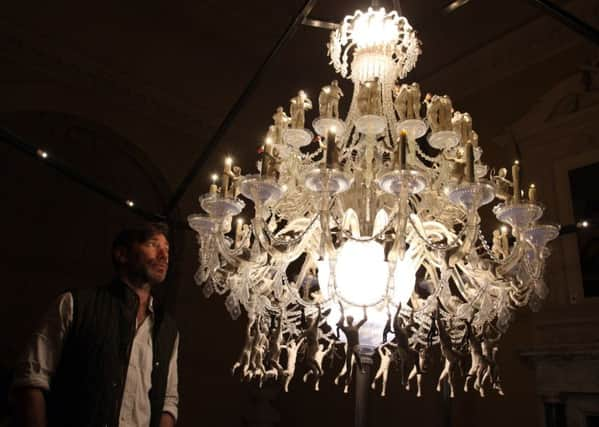Spin with sin: How I staged a drunken orgy at Fountains Abbey


Inside the Banqueting House, one of the many follies normally closed to the public, hangs a giant chandelier. On each tier sit figures. Some look like they are drinking wine, others hold oversize chicken legs. Then suddenly the lights go off and as the chandelier begins to spin it turns into a stop motion animation of ancient drunken debauchery. There’s wine being spat out, swinging monkeys and in the middle men urinate into eating bowls below. It’s a work which captures the trickery of Ray Harryhausen, but with added nudity and booze.
“I think children will love it,” says Collishaw, who was one of the artists who took part in the famous Freeze exhibition along with Damien Hirst and Tracey Emin back in 1988. “It’s about indulgence, it’s about insatiable appetites. From quite early on I knew what I wanted to do, but I didn’t have a structure on which to build it. I needed something which looked exactly the same through 360 degrees. Suddenly I was struck by the idea of a chandelier, which not only works in terms of the logistics of the piece, but also adds to the sense of opulence.”
Advertisement
Hide AdAdvertisement
Hide AdOver the other side of the park and sitting in direct contrast to Collishaw’s spinning orgy is the Pineal Eye. Housed in another of the park’s many follies, The Temple of Piety, a giant silver bowl is illuminated by a torch suspended from the ceiling. Inside is a statue which mirrors a relief on the back wall of the temple and which appears to grow and shrink depending on what spot you view it from.
“That should have been a simpler piece to build, but again it was all slightly last minute. The parabolic mirrors arrived at the studio. They had been lovingly wrapped to protect them during the transportation. Unfortunately a glue pot had been left inside which had been rattling around and the whole thing was scratched so we had to begin again.” Collishaw’s installations are the second of a three-year contemporary art programme for Fountains Abbey and Studley Royal. Part of the National Trust’s New Art Scheme, the hope is that they will entice people away from the estate’s imposing – and well-visited – ruins to check out the less frequented gardens.
“We know that many people who come to Fountains Abbey don’t get any further than the ruins, but actually it’s the grounds which are the reason for the estate’s Unesco World Heritage Status,” says Aimee Rawson, marketing and design manager for Fountains Abbey and Studley Royal. “Working with an artist of Matt’s calibre and standing is a first for us, but the work he has produced is compelling and I hope it encourages people to explore this elegant landscape a little further.”
Quirky, irreverent and playful, Collishaw has certainly channeled the spirit of the estate into his work. “When I was first approached about this commission I had a quick Google, but the first time I actually came up here was last June. It’s an impressive place and what you quickly realise is how the landscape has been designed to guide visitors to the best views. It might seem natural and understated, but actually it’s crying out, ‘look at me’, ‘look at this perfect scene’. I wanted to borrow a little of that sense of showing off for my pieces.”
Advertisement
Hide AdAdvertisement
Hide AdBack at his London studio and armed with various notes about his visit to Yorkshire, Collishaw began putting the flesh on the bones of what has become Folly! The spinning chandelier is built on a technique known as a 3D zoetrope. It’s one Collishaw has used before, but he admits he hadn’t quite realised what he was taking on.
“If I had, I probably wouldn’t have done it,” he says. “We built a six-week overrun into the original project, but even yesterday it still wasn’t quite finished. The figures were all made using 3D printers which gives a much smoother finish, but I think I have probably watched that thing spinning so much that it’s lost the initial impact. What I’m looking forward to now is seeing other people watch it for the first time. For me that’s what art is all about.
“Would I do it again? Well I would, but I’m not sure they would ask me back. Previously they commissioned three artists for one season of work, but what I wanted to do was so expensive that they could only afford me.”
Folly, Fountains Abbey and Studley Royal, to October 30.